Podcast
Questions and Answers
Which one of these is NOT a common misconception about fashion?
Which one of these is NOT a common misconception about fashion?
- Fashion acts as an influence on women only. (correct)
- Fashion is a mysterious and unpredictable force.
- Designers and retailers dictate what the fashion will be and then force it upon helpless consumers.
- Fashion is the most dynamic of American business.
Which one of these are principles of tangibles?
Which one of these are principles of tangibles?
- Designers and retailers dictate what the fashion will be
- Fashions are not based on price (correct)
- Social forces during a certain era
- Group acceptance
Which of the following make up the culmination stages of the fashion cycle?
Which of the following make up the culmination stages of the fashion cycle?
- Introduction and rise
- Rise and mass acceptance
- Acceleration and mass acceptance (correct)
- Rise and acceleration
Which of the following is NOT one of the 4 elements of design?
Which of the following is NOT one of the 4 elements of design?
Which of the following is NOT one of the trend general directions of movement of a fashion?
Which of the following is NOT one of the trend general directions of movement of a fashion?
Which of the following is not a style named after the time period it was evolved?
Which of the following is not a style named after the time period it was evolved?
Which of the following does NOT contribute to defining a FAD?
Which of the following does NOT contribute to defining a FAD?
What are the 4 elements of fashion design?
What are the 4 elements of fashion design?
The average American generates how many pounds of textile waste per year?
The average American generates how many pounds of textile waste per year?
Which of these is NOT one of the 6 R's of merchandising?
Which of these is NOT one of the 6 R's of merchandising?
What purpose are style numbers not used for?
What purpose are style numbers not used for?
Which of the following is the order in which fashion starts and ends?
Which of the following is the order in which fashion starts and ends?
The psychological environment of a consumer includes?
The psychological environment of a consumer includes?
Which one of these is NOT one of the four major factors affecting fashion?
Which one of these is NOT one of the four major factors affecting fashion?
Demographic segmentation involves all of the following except?
Demographic segmentation involves all of the following except?
Which of the following statements about the Middle Class in the United States is NOT true?
Which of the following statements about the Middle Class in the United States is NOT true?
Study Notes
Fashion Misconceptions and Principles
- Fashion is often misperceived as being dictated by designers and retailers, while it is actually influenced by broader consumer behaviors and trends.
- Key principle: Fashion is not solely based on price, highlighting the influence of social forces and cultural contexts.
Fashion Cycle Stages
- The culmination stages of the fashion cycle include acceleration and mass acceptance, marking a fashion's peak popularity.
Elements of Design
- Four core elements of fashion design include silhouette, details, texture, and color. Cost is not considered an element of design.
Trend Direction
- The emergence of a trend does not depend solely on broad consumer buying but rather on the activity of leading designers and retailers within the fashion industry.
Styles and Fads
- Not all styles are named after their historical context; examples include the gaucho pant.
- A fad is characterized by its rapid rise and fall in popularity, with a limited audience and quick disappearance.
Textile Waste
- Average textile waste generated by an American per year is 84 pounds, raising environmental awareness regarding fashion consumption.
Merchandising Principles
- Critical components of merchandising include the right time, quantities, price, and promotions tailored for specific customers, excluding the influence of sales associates.
Fashion Hierarchy
- The sequence of fashion movement begins with high fashion, followed by mass fashion, and finally fast fashion, demonstrating the flow from exclusivity to accessibility.
Consumer Psychology
- Factors influencing consumer behavior include reactions to societal norms, the need for self-assurance, and desire for companionship, integrating psychological aspects into fashion consumption.
Factors Affecting Fashion
- Major factors influencing fashion trends encompass market segmentation (geographics, demographics, psychographics), economic conditions, and sociological characteristics of class structure.
Demographic Segmentation
- Demographic segmentation includes critical factors such as age, gender, occupation, education, race, and nationality, all contributing to understanding consumer markets.
Middle Class Dynamics
- The middle class constitutes a key demographic for the US economy, with a notable income range of approximately $26,000 to $80,000. It plays a significant role in consumer behavior and marketing strategies.
Studying That Suits You
Use AI to generate personalized quizzes and flashcards to suit your learning preferences.
Description
Test your knowledge with flashcards covering key concepts from Chapters 1-4 of Fashion Merchandising. Learn to distinguish between common misconceptions about the fashion industry and gain a deeper understanding of its dynamics. This review will help solidify your grasp of the fashion merchandising principles discussed in class.




